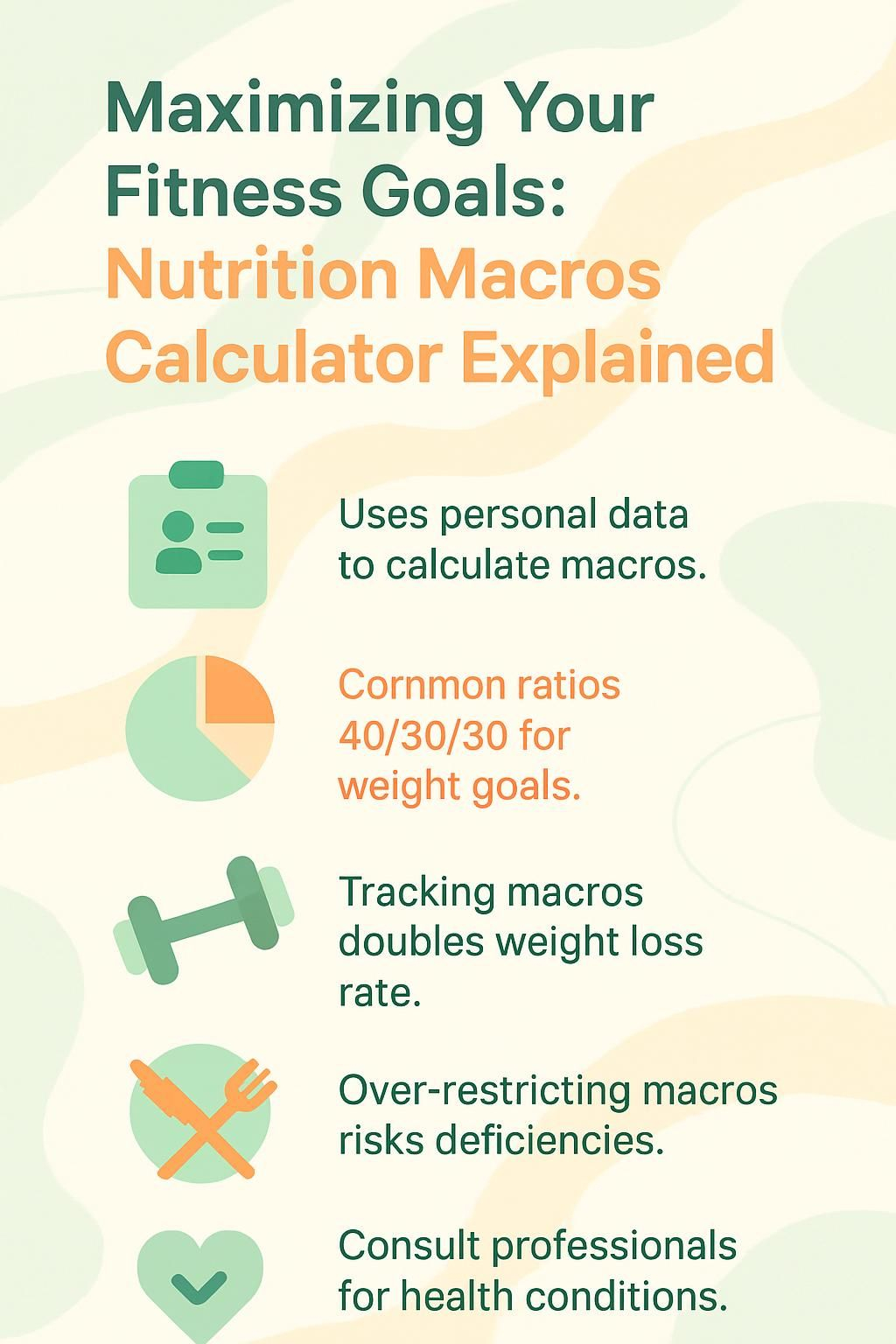Maximizing Your Fitness Goals: Nutrition Macros Calculator Explained
Our Nutrition Assistant AI Suite will transform your body. You will lose fat, get toned, and build muscle. Gain confidence and optimal health.
Struggling to hit fitness goals even though you watch your food closely? Understanding each macronutrient, the carbs, protein, and fat in your meals, can change your results. A simple macros calculator gives clear daily targets so you can plan smarter, eat a balanced diet, and track progress with less guesswork.
This guide walks you through how macros work, how to set your macronutrient ratio, and how to adjust over time. You will learn which food sources help most and how to read a nutrition label with confidence. Small changes add up when you follow a plan that fits your routine.
Key Takeaways
- A macros calculator uses age, sex, body weight, height, and activity level to estimate daily targets for protein, carbohydrates, and fat.
- Common macro splits are 40 percent carbs, 30 percent protein, and 30 percent fat for weight loss or muscle gain; maintenance often shifts to 50 percent carbs, 30 percent protein, and 20 percent fat.
- People who track food intake may lose weight at nearly double the rate of non-trackers, based on research in the International Journal of Obesity, 2021.
- Over-restricting any macronutrient can lead to low energy or nutrient gaps. Steady, balanced eating supports long-term health better than extreme diets.
- If you have diabetes, kidney disease, allergies, or other medical needs, talk with a registered dietitian before making major macro changes.

What Are Macronutrients?

Macronutrients are the nutrients your body needs in larger amounts for energy and growth. Learning how macronutrients work helps you set realistic goals and build meals that support them.
What are macronutrients?
Macronutrients give your body energy and help it work properly. There are three types: carbohydrate, protein, and fat. Carbohydrates and protein provide 4 calories per gram. Fat provides 9 calories per gram.
These nutrients come from common foods like grains, meat, dairy, beans, nuts, oils, vegetables, fruits, and seeds. They support your metabolism and fuel daily activity. All foods contain varying percentages of macro- and micronutrients.
Carbohydrates supply glucose, the main fuel for your muscles and brain. Protein supplies amino acids that build and repair muscle tissue. Dietary fats help absorb vitamins like A and D and support hormone production. Your ideal mix depends on your age, body weight, health goals, and daily calorie needs.
What are the three main macronutrients?
Carbohydrates include foods like whole grains, bread, quinoa, and cereal. They are your body’s quick energy. Protein comes from lean meats, fish, legumes, eggs, and dairy. It repairs tissues and supports muscle growth. Fat protects your organs, aids vitamin absorption, and supports hormones. Healthy fats come from avocados, nuts, seeds, fatty fish, and olive oil.
Water does not provide calories, so it is not a macronutrient. Fiber is a type of carbohydrate. Many people find macro tracking makes meals feel more intentional. For example, you might eat more carbs before workouts for energy, then focus on protein at dinner for recovery.
How do macronutrients differ from micronutrients?
Macronutrients provide energy and are needed in larger amounts. You often track them in grams to match goals like fat loss or muscle gain. Micronutrients include vitamins and minerals such as calcium, iron, vitamin A, and zinc. Your body needs these in small amounts, often measured in milligrams or micrograms.
Both come from food, but they play different roles. Hitting macro targets helps meet calorie needs and energy demands. Eating a wide variety of foods helps you meet micronutrient needs for bone health, immunity, and healthy skin.
Why Are Macronutrients Important for Fitness Goals?
Think of macros as the building blocks that power your training and recovery. Balancing them is how you match food energy to your goals.
How do carbohydrates provide energy?
Carbohydrates break down into glucose during digestion. Glucose travels in your blood and fuels your muscles and brain. Extra glucose is stored as glycogen in the liver and skeletal muscle for quick energy during activity.
Complex carbs, such as whole grains, vegetables, and legumes, release energy slowly. They help you avoid blood sugar crashes that lead to fatigue. Many people aim for 45 to 65 percent of daily calories from carbs, then adjust based on training. During half-marathon prep, a bowl of oatmeal before runs can provide steady energy without a mid-workout crash.
Why is protein important for muscle repair and growth?
Exercise creates tiny tears in muscle fibers. Protein supplies the amino acids your body needs to repair and rebuild them. General guidance suggests at least 0.8 grams of protein per kilogram of body weight each day. For someone weighing 150 pounds, that is about 54 grams.
Athletes and people focused on muscle gain often eat more to support recovery and growth. Good sources include eggs, chicken breast, Greek yogurt, beans, tofu, and lean beef. Protein also helps with satiety, so you feel full longer after meals.
What are the benefits of healthy fats for wellness?
Healthy fats, including monounsaturated and polyunsaturated fats, support hormone production and metabolism. They also provide a steady energy source for longer workouts or lower carb days. Fats help your body absorb vitamins A, D, E, and K.
Guidelines suggest 20 to 35 percent of calories from fat, with saturated fat under 10 percent. Many people feel more satisfied after meals that include nuts or avocados compared with low-fat meals. Choose staples like olive oil, salmon, sardines, seeds, and nuts to support heart health without excess trans fat.
Understanding the Macronutrient Ratio
Your macro split is a tool, not a rule, and it should evolve as your goals do.
Customizing macro ratios for your fitness goals
You will need to adjust your macronutrient ratio based on your goal, body weight, and activity level. There is no single perfect split for everyone.
- Set a clear goal first, such as fat loss, muscle gain, or maintenance.
- Use a macros calculator to enter age, sex, height, weight, basal metabolic rate, and activity level.
- Adjust carbs for energy needs. Endurance training usually requires more carbs. Lower carb approaches may suit people with insulin resistance, with medical guidance.
- Increase daily protein if you want muscle growth, since protein supports muscle protein synthesis and repair.
- Include healthy fats to aid vitamin absorption and hormone support. Good sources include nuts, avocado, fish oil, and olive oil.
- Track dietary fiber from whole grains and vegetables to support digestion and steady blood sugar.
- Avoid extreme cuts to any macro. Very low fat or very low carb plans can harm energy and nutrient intake.
- Recheck your macro targets every few weeks. Update them as training, weight, or routine changes.
- Consult a registered dietitian for medical conditions or complex body composition goals.
Common macro ratios for weight loss, muscle gain, and maintenance
These sample ranges offer a simple starting point. Adjust based on your results and how you feel.
| Fitness Goal | Carbohydrates (%) | Protein (%) | Fat (%) | Example Plate Composition |
|---|---|---|---|---|
| Weight Loss | 40 | 30 | 30 | About two-thirds whole grains, vegetables, fruits, nuts, seeds; one-third lean protein |
| Muscle Gain | 40 | 30 | 30 | About two-thirds whole grains, vegetables, fruits, nuts, seeds; one-third lean protein |
| Maintenance | 50 | 30 | 20 | About two-thirds whole grains, vegetables, fruits, nuts, seeds; one-third lean protein |
- Both weight loss and muscle gain often start with 40 percent carbs, 30 percent protein, and 30 percent fat.
- Maintenance commonly shifts to 50 percent carbs, 30 percent protein, and 20 percent fat.
- Fill about two-thirds of your plate with whole grains, vegetables, fruits, nuts, and seeds.
- Use the last third for lean protein such as chicken, fish, beans, or quinoa.
What Is a Nutrition Macros Calculator?
A nutrition macros calculator uses your personal data to estimate a daily balance of carbohydrates, protein, and fat, plus total calories. It helps turn broad advice into a clear plan you can follow.
What is a macros calculator?
A macros calculator is an online tool that estimates your daily needs for carbs, protein, and fat. You enter basic details such as age, sex, weight, height, activity level, and goal. The tool then suggests total calories and grams per macro for your day.
These estimates use research-based formulas to align food energy with your body’s needs. Many athletes use a calculator to guide meal planning and track grams of protein, carbs, and fat with more accuracy.
How does a macros calculator work?
You enter your age, sex, height, weight, activity level, and goal. The calculator estimates your basal metabolic rate, or BMR, which is the calories your body needs at rest. Methods like Mifflin St Jeor or Katch McArdle are common.
Next, the tool applies your activity level to find total daily energy needs. Then it divides that number into targets for carbohydrates, protein, and fat. If you choose a higher protein target or a lower fat pattern, the tool shifts the ratio to match.
What factors affect macros calculations?
Age, sex, height, weight, activity level, and goals all change your macro targets. Muscle mass usually raises calorie needs compared to the same weight with less muscle. A very active person will have higher energy needs than someone who sits most of the day.
Medical conditions also matter. For example, people with diabetes often manage carbohydrate intake closely. Some calculators let you choose units like pounds or kilograms and feet or centimeters. More precise input gives more useful output.
Summary: Calculators rely on your personal details and current routine. As your body or training changes, update your inputs and adjust your macro mix to keep results on track.
How to Use a Macros Calculator
Using a calculator is simple. Careful input yields better guidance, and small updates keep your plan current.
How do you input personal data into a macros calculator?
Start with your age, sex, height, and weight. Choose height in feet and inches or centimeters, and weight in pounds or kilograms. Select your activity level, such as sedentary, lightly active, moderately active, very active, or extra active.
Pick your goal: lose weight, gain muscle, or maintain weight. Having recent measurements makes the process faster and more accurate. Good inputs lead to a macro breakdown that fits your day and your training.
How do you interpret macros calculator results?
Your results usually list daily grams for carbohydrates, protein, and fat. For example, a muscle gain plan might suggest 250 grams of carbs, 120 grams of protein, and 60 grams of fat. These numbers line up with general guidance from groups like the CDC and WHO.
Treat the output as targets that guide your shopping and meal prep. If your split is 40 percent carbs, 30 percent protein, and 30 percent fat, aim to match that in your meals. Use the ranges to build structure, then adjust based on hunger, energy, and progress.
How do you adjust macros based on progress?
Track body weight, performance, measurements, and energy each week. If you want to lose 1 pound per week, set about a 500 calorie daily deficit. If progress stalls for several weeks, update your weight in the calculator and review your activity level. You can lower carbs or fat slightly while keeping protein steady.
For muscle gain, increase calories slowly, usually 100 to 200 calories per day at first. Add carbs or healthy fats, then evaluate. During marathon training, for example, bumping carbs by 10 percent for two weeks can improve recovery and pace if runs feel sluggish.
Benefits of Tracking Macros
Macro tracking turns vague goals into daily actions you can measure.
How does tracking macros help achieve fitness goals?
Tracking your macronutrients gives you control. A 2021 study in the International Journal of Obesity found that people who tracked intake lost weight faster than those who did not. Tracking supports muscle gain too, since you can dial in protein for recovery after hard sessions.
Logging food increases awareness and exposes hidden calories. With data, your choices align with your goals instead of guesswork. That often means better results, faster.
How does tracking macros promote balanced eating?
Tracking helps you include carbs, protein, and healthy fats at each meal. This supports steady energy, muscle repair, and long-term wellness. Following macro targets also reduces the chance that you skip important food groups.
As a simple rule, pick items with more protein than sugar per serving when possible. Keeping sugar under about 8 grams per serving for snacks can help manage calories and appetite.
How can tracking macros improve body composition?
Managing your macronutrient intake can lower body fat while protecting lean muscle. Research suggests higher protein supports muscle during fat loss and helps recovery after training.1,2 For example, raising protein while moderating extra carbs can support a leaner look and steady performance.
A nutrition macros calculator lets you personalize the macro mix for your specific goal. Athletes often use this method to reach performance or physique targets with fewer surprises.
References:
1. Longland TM et al., Am J Clin Nutr 2016;104(3):716-24.
2. Jäger R et al., J Int Soc Sports Nutr 2017;14:20.
Tips for Counting and Tracking Macros
Accuracy improves with simple habits. A few minutes of planning makes tracking smoother.
How do you read nutrition labels for macros?
First, check the serving size. The listed grams of carbohydrates, protein, and fat apply to that serving. Under carbohydrates, note sugars and fiber. For snacks and yogurt, aim for less than 8 grams of sugar per serving when you can.
Compare protein to sugar. For example, a Greek yogurt with 15 grams of protein and 5 grams of sugar is a better pick than one with 9 grams of protein and 12 grams of sugar. This quick scan helps you meet your macro targets across the day.
What are the best food tracking apps?
Look for accuracy, a large database, and easy logging. MyFitnessPal offers barcode scanning and broad food coverage. Cronometer tracks both macros and micronutrients in detail. Lose It! keeps logging simple and syncs with many devices. Macros+ zeroes in on protein, carbs, and fats if you want a focused tool.
Any of these apps can chart weekly averages so you can see trends for carbs, protein, and fat. Pick the one you enjoy using, since consistency matters most.
How can meal prepping improve macro tracking accuracy?
Meal prep lets you measure and portion food in advance. Weigh ingredients, log them once, and save the recipe in your app. This reduces guesswork during busy days and keeps you close to your targets.
Planning five lunches at once makes it easy to hit a steady protein target, like 150 grams of chicken per meal. Many people find their calorie counts more stable when breakfasts are prepped for the week.
Challenges and Limitations of Macro Tracking
Macro tracking is a tool. It works best when it fits your life and your health needs.
Why isn’t macro tracking a one-size-fits-all approach?
Your needs change with age, weight, medical conditions, and daily habits. People with diabetes often manage carbohydrate intake closely. Athletes may need more protein for recovery.
Strict tracking can feel difficult during travel, cultural events, or busy seasons. Adjust your calculator settings based on real progress and how you feel. Flexibility supports better long-term habits.
What are the risks of over-restricting macros?
Severely limiting carbs can cause low energy, headaches, and poor focus, especially if you train hard. Overemphasizing protein while skimping on healthy fats or carbs can also create problems over time. Many extreme diets fail because they lack balance and are hard to maintain.
A varied diet protects performance, mood, and recovery. Balance is the safer path than cutting entire macronutrients for quick results.
When should you consult a dietitian or nutritionist?
Meet with a registered dietitian if you have a medical condition, such as diabetes, kidney disease, or food allergies. Professional guidance helps you set safe macro ranges that also hit health targets.
Major diet changes deserve expert input to avoid deficiencies or other risks. This content is educational and not a substitute for medical advice.
Macronutrient Food Sources
Pick foods that supply carbohydrates, protein, and fats in amounts that match your targets.
What are good carbohydrate-rich foods?
Whole grains like brown rice, oats, and whole wheat bread deliver steady energy. Beans and lentils add fiber and slow-digesting carbs that help stabilize blood sugar. Vegetables such as sweet potatoes, corn, and peas offer vitamins along with carbs.
Fruits like apples, oranges, bananas, and berries provide natural sugars and key nutrients. Swapping white bread for oats or quinoa often leads to better energy during afternoon workouts.
What are common protein-rich foods?
Animal sources include skinless poultry, eggs, fish, lean beef or pork, and dairy such as Greek yogurt and cottage cheese. For example, a 3 ounce serving of chicken breast has about 26 grams of protein, and one large egg has around 6 grams.
Plant options include beans, lentils, tofu, tempeh, quinoa, nuts, and seeds. A half-cup of cooked lentils provides about 9 grams of protein, and 3 ounces of firm tofu provides about 8 grams.
Which foods provide healthy fats?
Nuts like almonds and walnuts provide monounsaturated and polyunsaturated fats. Seeds such as chia and flax add healthy fats and fiber. Avocados are rich in unsaturated fat and also provide potassium.
Fatty fish like salmon contain omega-3s that support heart health. Use olive oil instead of butter to increase beneficial fats and limit saturated fat. Aim to keep saturated fat under 10 percent of daily calories.
Common Macro Tracking Mistakes to Avoid
A few common errors can slow progress. Spot them early and your results will improve.
Why should you avoid ignoring hidden calories?
Hidden calories can push you over your targets without noticing. Oils, sauces, and dressings are common culprits. One tablespoon of oil has about 120 calories. A small handful of nuts can add 150 to 200 calories.
Logging these extras shows where your calories come from. That insight helps you shape meals that match your plan.
What happens if you neglect micronutrients?
If you focus only on macros, you might miss important vitamins and minerals. Low vitamin D, iron, or calcium can lead to fatigue, weaker immunity, and slow recovery. The CDC has reported notable nutrient gaps among Americans.
Bloodwork once showed my iron and vitamin B12 were low during a busy training phase. Adding leafy greens and fortified cereals helped restore energy. Macro targets are important, and micronutrients matter too.
Why is focusing too much on numbers a mistake?
Tracking every gram can make eating feel rigid. Sticking to numbers without caring about food quality can lead to low fiber or few vegetables. Some research links rigid dieting to higher stress and lower adherence over time.
Use numbers as guides, not strict rules. Choose nutrient-dense foods first, then fine tune the math.
Tips for Balancing Your Macros
Consistency wins. Keep your plan steady and flexible so it fits real life.
How do you incorporate a variety of foods?
Rotate whole grains like oats, brown rice, and quinoa. Eat several colors of vegetables and fruits each day. Include nuts and seeds for healthy fats.
Switch up protein sources: lean meats, fish, eggs, Greek yogurt, cottage cheese, beans, lentils, tofu, and tempeh. A macros calculator helps you balance your plate across the week. Variety supports macro balance and improves micronutrient coverage too.11 Drewnowski A., et al., American Journal of Clinical Nutrition, 2020.
How do you adjust macros for lifestyle changes?
Update your macros when your routine shifts. If you add runs or longer lifts, increase carbs to fuel the work. If your days become more sedentary, lower calories and adjust carbs while keeping protein steady.
Open your calculator, update weight, activity, or goals, and review the new targets. Regular check-ins keep your plan aligned with your current needs.
How can you stay consistent without obsessing?
Use your calculator as a guide, not a judge. Leave room for social meals and special events. Aim for weekly consistency rather than single-meal perfection.
People who build simple routines often see better long-term results. If a day goes off-plan, get back to basics at the next meal.
The Science Behind Macronutrient Needs
Your body uses macronutrients to power movement and repair tissue. Matching intake to training supports better performance.
How do macronutrients fuel workouts?
Carbs are the main fuel for high-intensity exercise. They break into glucose, which powers muscles and brain. Fats provide longer-lasting energy during extended or lower-intensity efforts.
Protein helps repair muscle after training. Getting enough of all three leads to faster recovery and better performance over time. Eating carbs before a game can boost stamina, and a protein shake after can reduce soreness.
What role do macros play in metabolism and energy balance?
Protein supports tissue repair and has a higher thermic effect of food, which means your body uses more energy to digest it. Fat delivers 9 calories per gram and supports hormones and long-term energy. Carbs fill quick energy needs and help control training output.
Your daily calories depend on age, size, activity level, and goals. Tracking macros helps you meet those needs with steady energy instead of spikes and crashes.
Should You Count Macros?
Counting macros gives structure to your nutrition plan. The method works best when you keep it practical and personal.
Who benefits most from counting macros?
People focused on weight loss, muscle gain, or body composition often see strong results with macro tracking. Athletes use it to match energy and protein to training loads. Individuals with medical needs can also benefit from closer monitoring, under professional care.
Higher protein during fat loss can help preserve lean body mass. Adjust carbs for energy and fats for hormonal health to support your goal.
What are alternatives to macro counting for nutrition?
You can build balanced plates without tracking. Try the plate method: fill half with non-starchy vegetables, one-quarter with lean protein, and one-quarter with whole grains or starchy vegetables. This covers most needs without any math.
Intuitive eating focuses on hunger and fullness cues while choosing nutritious foods. Many people work with a dietitian to craft simple meal patterns that fit training and lifestyle, without strict counting.
Conclusion
Mastering your macros makes nutrition simpler and more effective. A macros calculator gives clear targets for protein, carbs, and fat. Honest inputs bring accurate results. Consistent tracking helps every meal move you closer to your goal.
Keep your plan flexible. Update macros as training, weight, or routine changes. If you have medical concerns, seek advice from a registered dietitian or healthcare provider. With smart tracking and balanced choices, your fitness goals are within reach.
FAQs
1. What is a nutrition macros calculator and how does it help with fitness goals?
A nutrition macros calculator estimates the daily amounts of protein, carbohydrates, and fats needed to support specific fitness objectives such as muscle gain or weight loss. Research shows that tracking these nutrients can improve body composition outcomes for adults who exercise regularly (Helms et al., 2014). Using this tool helps you align your food choices with your training plan.
2. How do I use a nutrition macros calculator effectively?
To use the calculator, enter personal details like age, gender, weight, height, activity level, and goal. The tool then provides recommended grams of each macronutrient per day. For example:
– Protein: 1.6–2.2 grams per kilogram of body weight
– Carbohydrates: Varies by activity but often ranges from 3–7 grams per kilogram
– Fats: Usually set at about 20–35% of total calories
These values are based on guidelines from organizations such as the Academy of Nutrition and Dietetics.
3. Can adjusting my macro intake really change my results?
Yes; studies confirm that changing protein or carbohydrate levels can affect muscle growth or fat loss (Phillips & Van Loon, 2011). In my experience as an amateur athlete using a macro tracker led to more consistent energy during workouts and better recovery after intense sessions.
4. Are there risks in relying only on a macros calculator for meal planning?
Relying solely on numbers may cause you to overlook micronutrients like vitamins or minerals which also impact health (Slavin & Lloyd, 2012). It is important to eat varied foods including fruits and vegetables alongside meeting macro targets.
Summary: A nutrition macros calculator offers evidence-based guidance for setting protein, carbohydrate, and fat goals tailored to individual needs; however balanced eating remains essential for overall well-being while pursuing fitness milestones.







